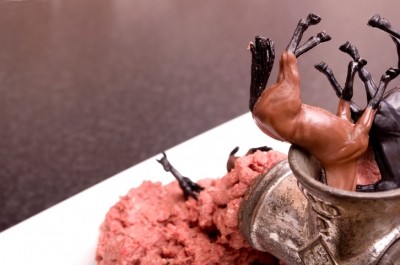Identifying ‘food fingerprints’ to combat crime: ‘Fraud is a growing concern’

‘Food fingerprints’ – when used as biomarkers – can be used to test food quality, safety and authenticity.
Defined as molecular markers that represent a characteristic food state or condition, the fingerprints (biomarkers) should be measured, evaluated and validated objectively, allowing scientists to distinguish between genuine and fraudulent products.
“Essentially, [food fingerprints] is a marker or set of markers that allow us to answer many questions about food authenticity, such as “Are those organic carrots truly organic? Does this saffron really originate from Spain? Can we discriminate between orange juice and pulp wash?” postdoc researcher Sonia Medina, from Portugal’s University of Madeira, told FoodNavigator.
“The search for these fingerprints is not only related with the quality of the products, but also with the safety to human health.”
The study assigns biomarkers according to environmental, genetic or human alterations (adulteration) and was prompted by the rise of food crime in recent years.
“In the last decade, food fraud and counterfeit products produced to obtain economic advantages have become a growing concern,” said Medina.
Using fingerprints as biomarkers, regulators can assess food safety and authenticity to mitigate this problem and protect public health, she continued.
“When there is a food suspected of adulteration, rapid and robust methods, as well as specific and reliable markers, must be available to support the withdraw of such products from the food chain and act against the facilitators of that fraud.”
As each food compound has different physiochemical properties, particularly regarding amino acids, phenolic compounds, sugars and organic acids, it is important to identify biomarkers that can reliably discriminate among food samples.
Different analytical platforms, such as chromatography, mass spectrometry or spectroscopy can help identify the appropriate biomarker, Medina explained.
“In addition, the information about the number of samples used in each study, chemometric models applied, and the validation of these models will be very relevant for the strength of the putative biomarker identified and the robustness of the respective assay in order to guarantee the food authenticity and safety.”
Authentication protocols suffer from ‘weak communication between consumers and producers’
According to Medina, detecting and quantifying biomarkers that are able to certify the origin, variety of food production system, and detect food adulteration or spoilage, relies on a number of analytical platforms.
However, it is difficult to select the ‘best’ statistical model, Medina argued. “Because all of them present negative and positive characteristics.
“This is one of the greatest gaps in food authentication protocols that, together with the lack of supervision from government‘s authorities and the weak communications between consumers and producers, is making food authenticity certification a demanding and very challenging process to food handlers and food standardization authorities.”
Better analytical performances – such as non-destructive techniques and real-time food authentication – will not only confirm the existence of a given biomarker, but also accurately quantify it, she continued. “A feature that will be very relevant in the definition of spoilage markers and food safety.”
We need to ensure food is ‘not only healthier, but safer’
By providing a useful guide of potential biomarkers for food authenticity and safety, the study aims to contribute to current regulatory frameworks.
However, reducing food fraud will require a holistic response from regulators, policymakers, and industry, we were told.
“Authorities must promote the development of updated and interconnected biomarker databases that allow specific food ingredients categories vulnerable to adulteration to be identified.
“Moreover, the communication between consumers and producers or industries should be increased to avoid that food authenticity certification is not extremely challenging process for both food handlers and food standardization authorities,” said Medina.
Increased collaboration between companies and public authorities is required to protect future generations of consumers, she continued.
This, Medina said, will ensure they are “even more informed, assuring that food should be not only healthier and safer, but also be obtained through sustainable procedures that respect animal welfare and are environment-friendly.”
Source:
Food Chemistry
‘Food fingerprints – A valuable tool to monitor food authenticity and safety’
Published 25 April 2019
DOI: https://doi.org/10.1016/j.foodchem.2018.11.046
Authors: Sonia Medina, Jorge A. Pereira, Pedro Silva, Rosa Perestrelo, José S. Câmara
























